Power electronic handbook
Подождите немного. Документ загружается.

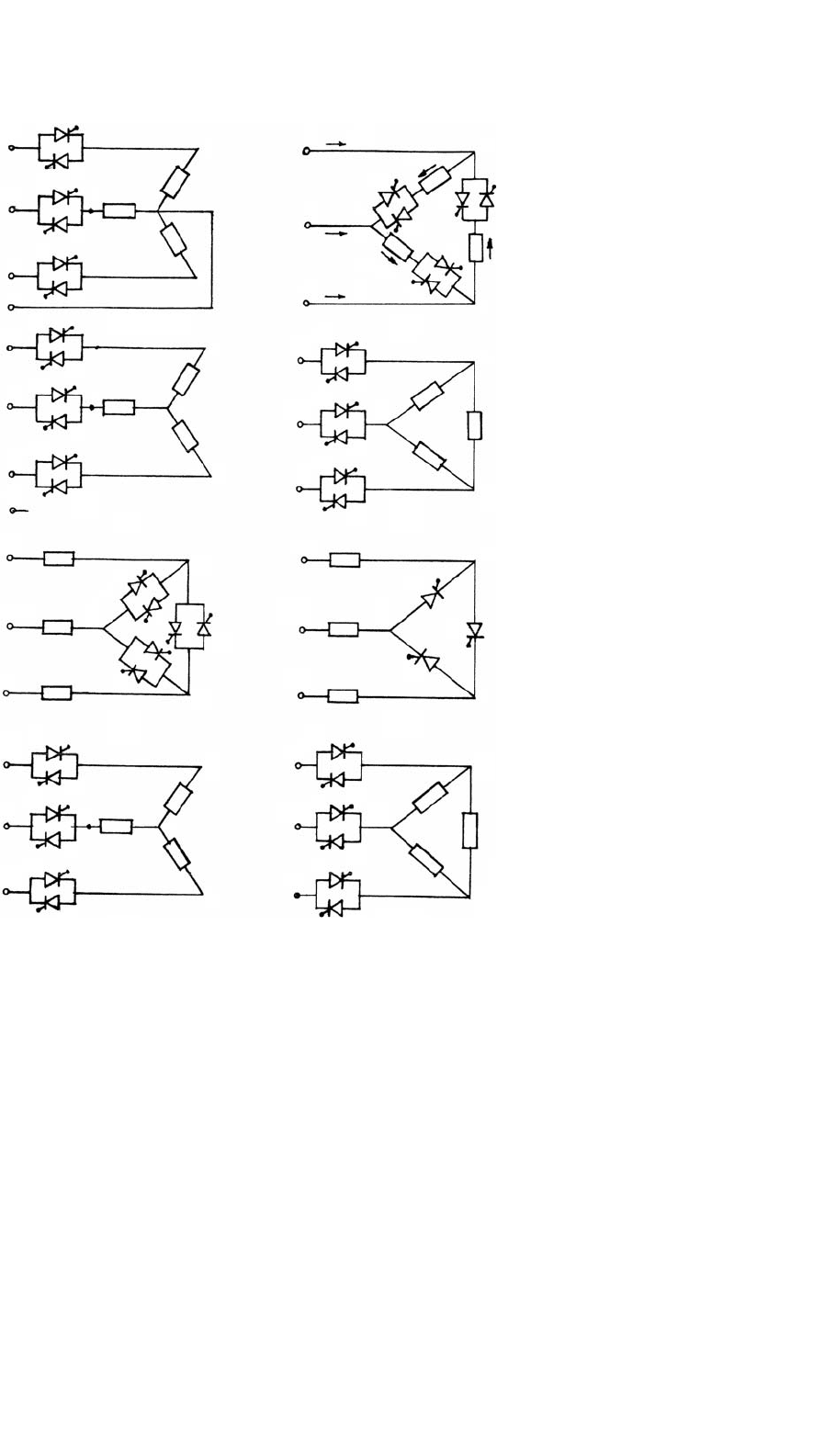
18 AC–AC Converters 489
T
1
T
3
T
5
T
2
T
1
T
3
T
5
T
6
T
2
T
1
T
4
T
6
T
3
T
1
D
4
D
6
D
2
b
n
a
c
T
3
T
5
T
2
T
5
c
(e)
(g)
(c)
a
T
4
T
6
T
4
A
B
C
N
A
A
B
C
A
B
C
b
B
C
N
b
a
c
a
c
n
b
(a)
n
i
a
T
1
T
2
T
6
T
3
T
4
T
5
i
c
i
b
i
bc
i
c
T
1
T
3
T
5
T
4
T
6
T
2
T
1
T
2
T
1
T
3
T
5
D
4
D
6
D
2
T
3
(d)
c
b
i
ab
A
B
C
A
B
C
A
B
C
A
Bb
(h)
c
C
b
c
a
c
(f)
a
a
(b)
b
a
FIGURE 18.11 Three-phase ac voltage controller circuit configurations.
The configurations in (a) and (b) can be realized by three
single-phase ac regulators operating independently of each
other and they are easy to analyze. In (a), the SCRs are to
be rated to carry line currents and withstand phase voltages
whereas in (b) they should be capable to carry phase currents
and withstand the line voltage. In (b), the line currents are free
from triplen harmonics while these are present in the closed
delta. The power factor in (b) is slightly higher. The fir-
ing angle control range for both these circuits is 0–180
◦
for
R-load.
The circuits in (c) and (d) are three-phase three-wire cir-
cuits and are complicated to analyze. In both these circuits,
at least two SCRs, one in each phase, must be gated simulta-
neously to get the controller started by establishing a current
path between the supply lines. This necessitates two firing
pulses spaced at 60
◦
apart per cycle for firing each SCR. The
operation modes are defined by the number of SCRs conduct-
ing in these modes. The firing control range is 0–150
◦
. The
triplen harmonics are absent in both these configurations.
Another configuration is shown in (e) when the controllers
are connected in delta and the load is connected between the
supply and the converter. Here, current can flow between two
lines even if one SCR is conducting so each SCR requires one
firing pulse per cycle. The voltage and current ratings of SCRs
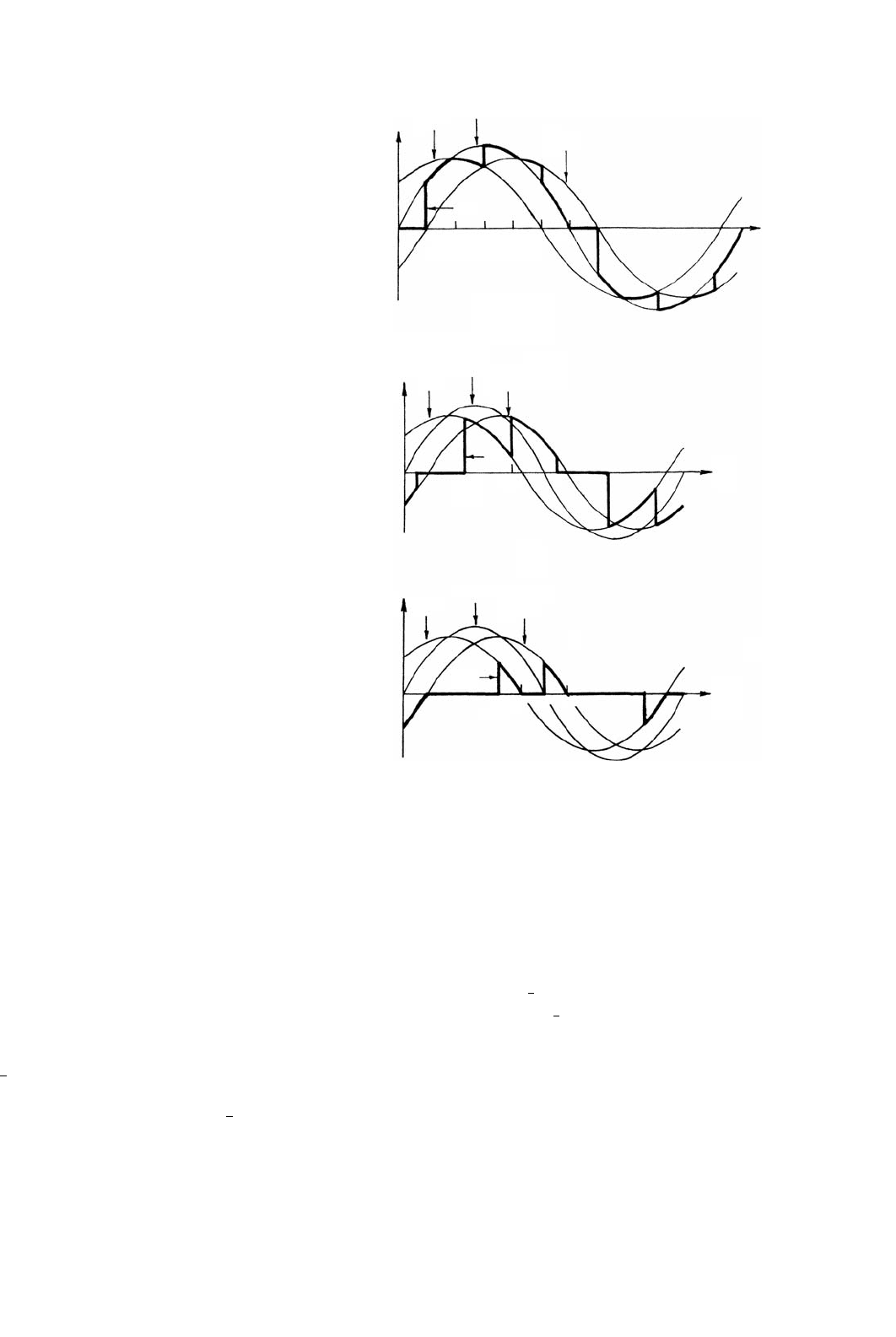
490 A. K. Chattopadhyay
are nearly the same as that of the circuit (b). It is also possible
to reduce the number of devices to three SCRs in delta as
shown in (f), connecting one source terminal directly to one
load circuit terminal. Each SCR is provided with gate pulses
in each cycle spaced at 120
◦
apart. In both (e) and (f), each
end of each phase must be accessible. The number of devices
in (f) is less, but their current ratings must be higher.
As in the case of single-phase phase-controlled voltage reg-
ulator, the total regulator cost can be reduced by replacing
six SCRs by three SCRs and three diodes, resulting in three-
phase half-wave controlled unidirectional ac regulators as
shown in (g) and (h) for star and delta connected loads. The
main drawback of these circuits is the large harmonic con-
tent in the output voltage – particularly, the second harmonic
because of the asymmetry. However, the dc components are
absent in the line. The maximum firing angle in the half-wave
controlled regulator is 210
◦
.
18.3.2 Fully Controlled Three-phase Three-wire
AC Voltage Controller
Star-connected Load with Isolated Neutral: The analysis of
operation of the full-wave controller with isolated neutral
as shown in Fig. 18.11c is, as mentioned, quite complicated
in comparison to that of a single-phase controller, particu-
larly for an RL or motor load. As a simple example, the
operation of this controller is considered here with a sim-
ple star-connected R-load. The six SCRs are turned on in the
sequence 1-2-3-4-5-6 at 60
◦
intervals and the gate signals are
sustained throughout the possible conduction angle.
The output phase voltage waveforms for α = 30
◦
,75
◦
, and
120
◦
for a balanced three-phase R-load are shown in Fig. 18.12.
At any interval, either three SCRs or two SCRs, or no SCRs may
be on and the instantaneous output voltages to the load are
either a line-to-neutral voltage (three SCRs on), or one-half of
the line-to-line voltage (two SCRs on), or zero (no SCR on).
Depending on the firing angle α, there may be three
operating modes:
Mode I (also known as Mode 2/3): 0 ≤ α ≤ 60
◦
; There are
periods when three SCRs are conducting, one in each phase
for either direction and periods when just two SCRs conduct.
For example, with α = 30
◦
in Fig. 18.12a, assume that at
ωt = 0, SCRs T
5
and T
6
are conducting, and the current
through the R-load in a-phase is zero making v
an
= 0. At
ωt = 30
◦
,T
1
receives a gate pulse and starts conducting;
T
5
and T
6
remain on and v
an
= v
AN
. The current in T
5
reaches zero at 60
◦
, turning T
5
off. With T
1
and T
6
staying
on, v
an
=
1
2
v
AB
.At90
◦
,T
2
is turned on, the three SCRs T
1
,
T
2
, and T
6
are then conducting and v
an
= v
AN
. At 120
◦
,T
6
turns off, leaving T
1
and T
2
on, so v
an
=
1
2
v
AC
. Thus with
the progress of firing in sequence till α = 60
◦
, the number of
SCRs conducting at a particular instant alternates between two
and three.
v
an
v
AB
v
an
(α)
(a)
(α)
(b)
(c)
3030° 60° 90°
75°
(α)
120° 150°180° 210°
135° 195°
ωt
ωt
ωt
120° 150° 180°
v
AN
₁
v
AC
₁
v
an
v
an
v
AB
v
AN
₁
v
AC
₁
v
an
v
AN
v
an
v
AB
₁
v
AC
₁
30°
FIGURE 18.12 Output voltage waveforms for a three-phase ac voltage
controller with star-connected R-load: (a) v
an
for α = 30
◦
; (b) v
an
for
α = 75
◦
; and (c) v
an
= 120
◦
.
Mode II ( also known as Mode 2/2): 60
◦
≤ α ≤ 90
◦
; Two
SCRs, one in each phase always conduct.
For α = 75
◦
as shown in Fig. 18.12b, just prior to α = 75
◦
,
SCRs T
5
and T
6
were conducting and v
an
= 0. At 75
◦
,T
1
is turned on, T
6
continues to conduct while T
5
turns off as
v
CN
is negative. v
an
=
1
2
v
AB
. When T
2
is turned on at 135
◦
,
T
6
is turned off and v
an
=
1
2
v
AC
. The next SCR to turn on is
T
3
which turns off T
1
and v
an
= 0. One SCR is always turned
off when another is turned on in this range of α and the output
voltage is either one-half line-to-line voltage or zero.
Mode III ( also known as Mode 0/2): 90
◦
≤ α ≤ 150
◦
; When
none or two SCRs conduct.
For α = 120
◦
, Fig. 18.12c, earlier no SCRs were on and
v
an
= 0. At α = 120
◦
, SCR T
1
is given a gate signal while
T
6
has a gate signal already applied. Since v
AB
is positive,
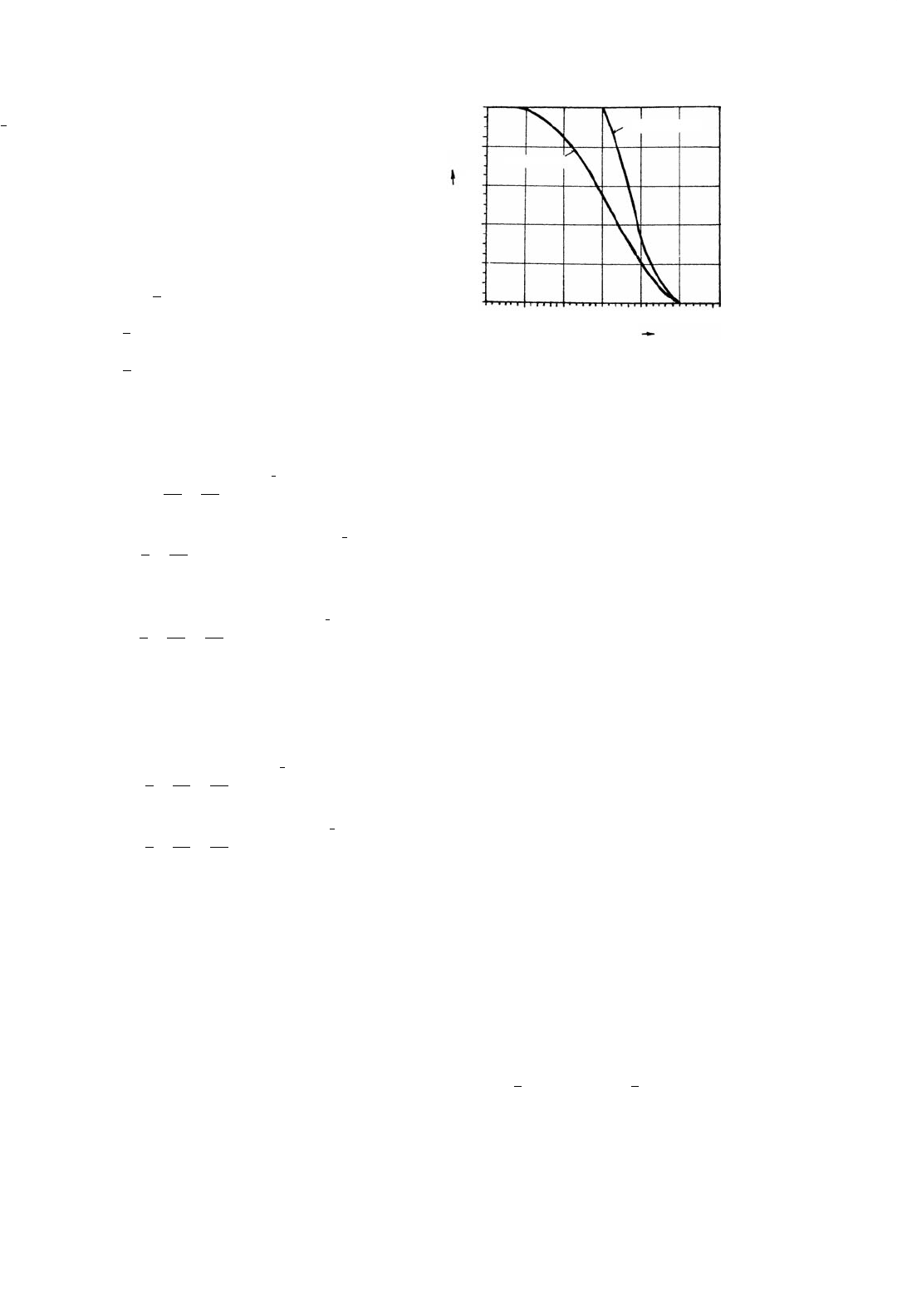
18 AC–AC Converters 491
T
1
and T
6
are forward biased and they begin to conduct and
v
an
=
1
2
v
AB
. Both T
1
and T
6
turn off, when v
AB
becomes
negative. When a gate signal is given to T
2
, it turns on and T
1
turns on again.
For α>150
◦
, there is no period when two SCRs are con-
ducting and the output voltage is zero at α = 150
◦
. Thus, the
range of the firing angle control is 0 ≤ α ≤ 150
◦
.
For star-connected R-load, assuming the instantaneous phase
voltages as
v
AN
=
√
2V
s
sin ωt
v
BN
=
√
2V
s
sin(ωt −120
◦
) (18.17)
v
CN
=
√
2V
s
sin(ωt −240
◦
)
the expressions for the rms output phase voltage V
o
can be
derived for the three modes as:
0≤α ≤60
◦
V
o
=V
s
1−
3α
2π
+
3
4π
sin2α
1
2
(18.18)
60
◦
≤α≤90
◦
V
o
=V
s
1
2
+
3
4π
sin2α+sin(2α+60
◦
)
1
2
(18.19)
90
◦
≤α≤150
◦
V
o
=V
s
5
4
−
3α
2π
+
3
4π
sin(2α+60
◦
)
1
2
(18.20)
For star-connected pure L-load, the effective control starts at
α>90
◦
and the expressions for two ranges of α are:
90
◦
≤α ≤120
◦
V
o
=V
s
5
2
−
3α
π
+
3
2π
sin2α
1
2
(18.21)
120
◦
≤α ≤150
◦
V
o
=V
s
5
2
−
3α
π
+
3
2π
sin(2α+60
◦
)
1
2
(18.22)
The control characteristics for these two limiting cases ( φ = 0
for R-load and φ = 90
◦
for L-load) are shown in Fig. 18.13.
Here also, like the single-phase case, the dead zone may be
avoided by controlling the voltage with respect to the control
angle or hold-off angle (γ) from the zero crossing of current
in place of the firing angle α.
RL Load: The analysis of the three-phase voltage controller
with star-connected RL load with isolated neutral is quite com-
plicated since the SCRs do not cease to conduct at voltage
zero, and the extinction angle β is to be known by solving
the transcendental equation for the case. The Mode II opera-
tion, in this case, disappears [1] and the operation shift from
1.0
0.8
0.6
0.4
0.2
0.0
03060
Firing Angle (α°)
L-LOAD (Φ=90°)
R-LOAD (Φ=0°)
90 120 150 180
V
o
/V
s
FIGURE 18.13 Envelope of control characteristics for a three-phase
full-wave ac voltage controller.
Mode I to Mode III depends on the so-called critical angle
α
crit
[2, 3] which can be evaluated from a numerical solution
of the relevant transcendental equations. Computer simula-
tion either by PSPICE program [4, 5] or a switching-variable
approach coupled with an iterative procedure [6] is a practical
means of obtaining the output voltage waveform in this case.
Figure 18.14 shows typical simulation results using the later
approach [6] for a three-phase voltage controller fed RL load
for α = 60
◦
,90
◦
, and 105
◦
which agree with the corresponding
practical oscillograms given in [7].
Delta-connected R-load: The configuration is shown in
Fig. 18.11b. The voltage across an R-load is the correspond-
ing line-to-line voltage when one SCR in that phase is on.
Figure 18.15 shows the line and phase currents for α = 130
◦
and 90
◦
with an R-load. The firing angle α is measured from
the zero crossing of the line-to-line voltage and the SCRs are
turned on in the sequence as they are numbered. As in the
single-phase case, the range of firing angle is 0 ≤ α ≤ 180
◦
.
The line currents can be obtained from the phase currents as
i
a
= i
ab
−i
ca
i
b
= i
bc
−i
ab
i
c
= i
ca
−i
bc
(18.23)
The line currents depend on the firing angle and may be dis-
continuous as shown. Due to the delta connection, the triplen
harmonic currents flow around the closed delta and do not
appear in the line. The rms value of the line current varies
between the range
√
2I
≤ I
L,rms
≤
√
3I
.rms
(18.24)
as the conduction angle varies from very small (large α)to
180
◦
(α = 0).
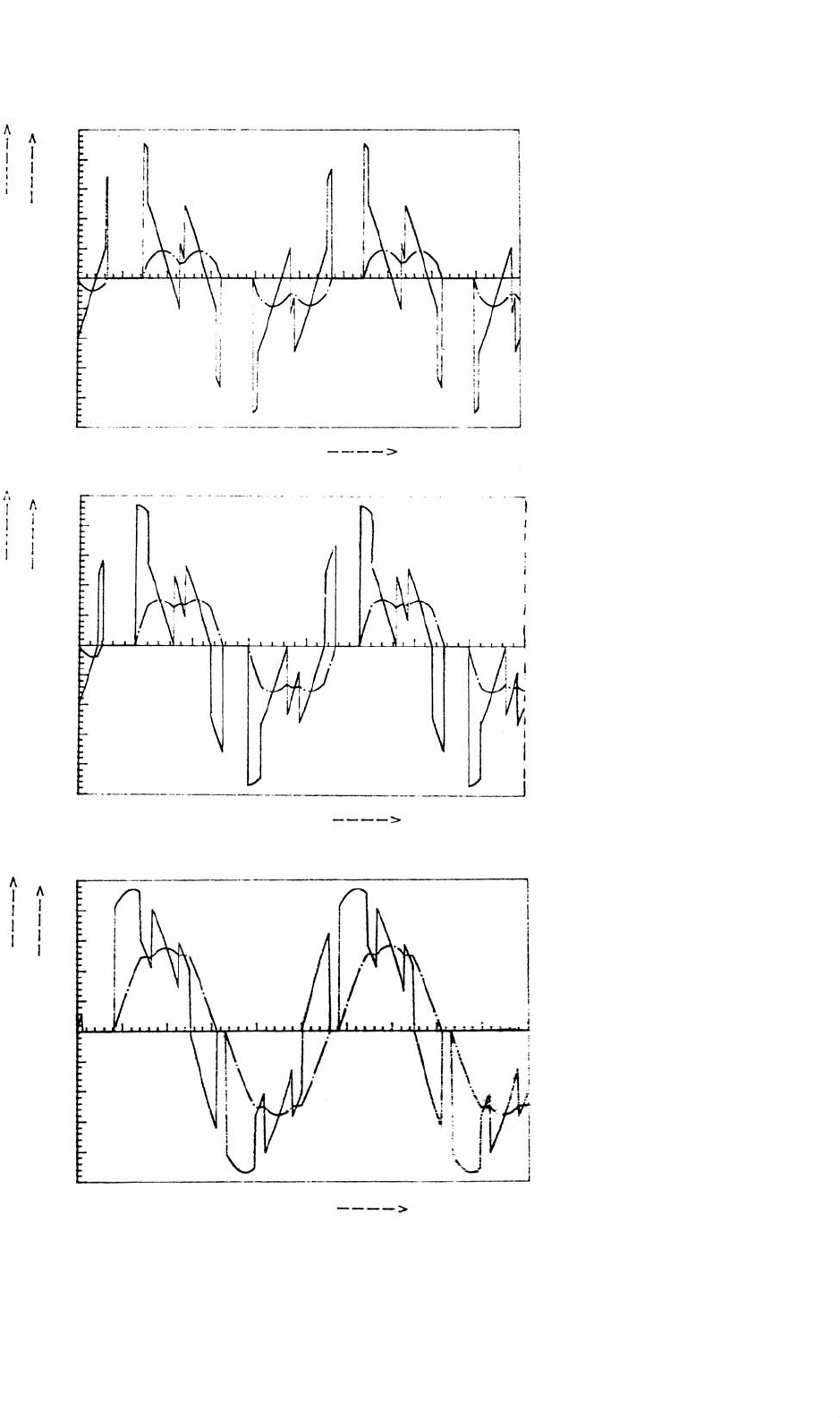
492 A. K. Chattopadhyay
Waveforms for R–L load (R = 1ohm L = 3.2mH)
Waveforms for R–L load (R = 1ohm L = 3.2mH)
Voltage
Phase current in amp
Phase voltage in volt
Phase current in amp
Phase voltage in volt
200
0.0
−200
200
0.0
−200
0.0
Time in sec.
Time in sec.
0.04
0.0
0.04
Current
α = 105deg.
Voltage
Current
α = 105deg.
Waveforms for R–L load (R = 1ohm L = 3.2mH)
Phase current in amp
Phase voltage in volt
200
0.0
−200
Time in sec.
0.0 0.04
Voltage
Current
α = 60deg.
FIGURE 18.14 Typical simulation results for three-phase ac voltage controller-fed RL load (R = 1 ohm, L = 3.2 mH) for α = 60
◦
,90
◦
, and 105
◦
.
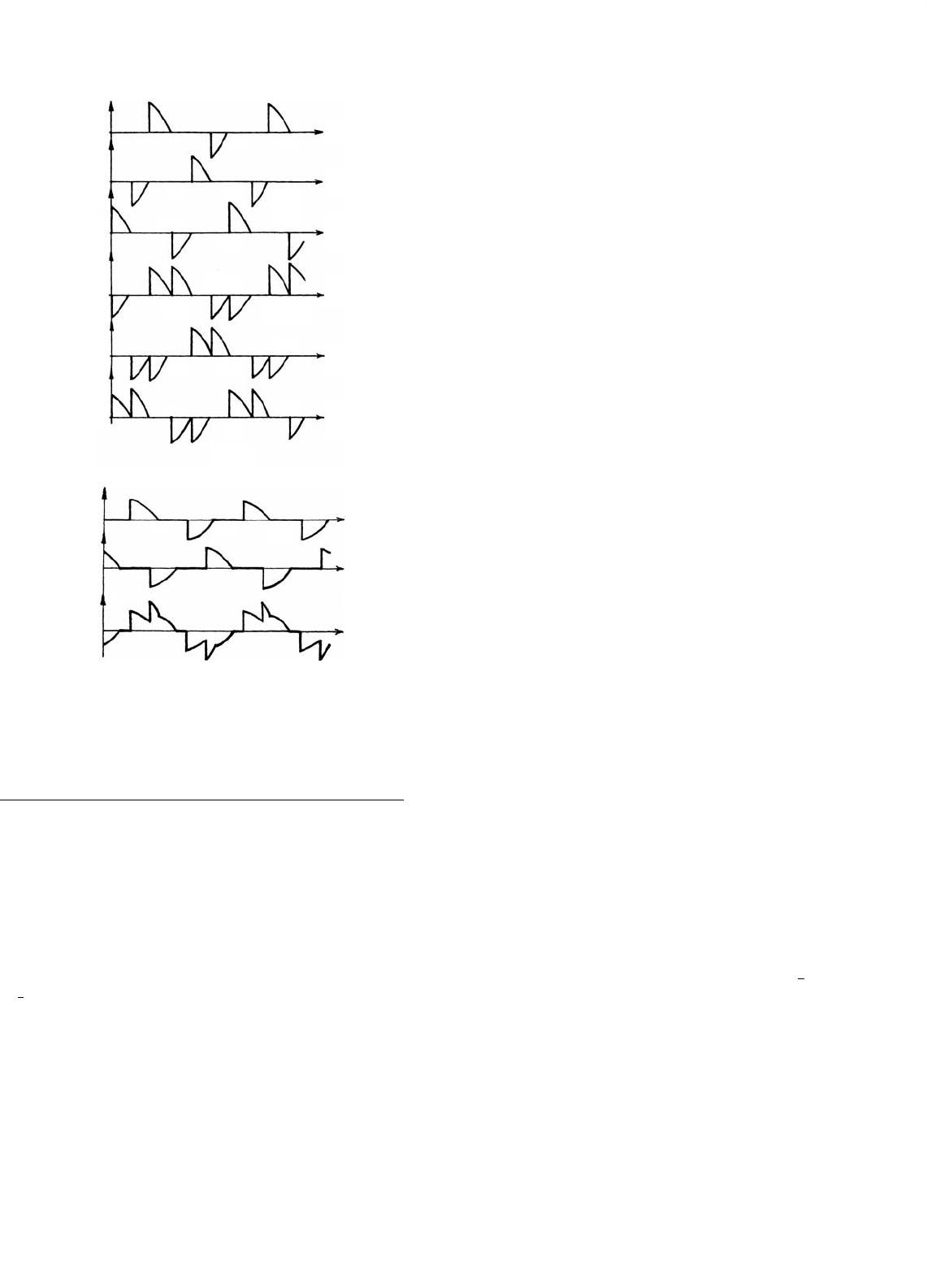
18 AC–AC Converters 493
i
ab
0
0
0
0
0
0
0
0
2π
2π
π
3π
3π
ωt
ωt
2π
π
3π
ωt
2π
2π
π
3π
π
3π
2ππ 3π
ωt
ωt
ωt
2ππ 3π
ωt
ωt
ωt
(b)
(a)
π
0
i
bc
i
ca
i
a
i
b
i
c
i
ab
i
ca
i
a
=i
ab
−i
ca
FIGURE 18.15 Waveforms of a three-phase ac voltage controller with
a delta connected R-load: (a) α = 120
◦
and (b) α = 90
◦
.
18.4 Cycloconverters
In contrast to the ac voltage controllers operating at con-
stant frequency, discussed so far, a cycloconverter operates
as a direct ac–ac frequency changer with inherent voltage
control feature. The basic principle of this converter to con-
struct an alternating voltage wave of lower frequency from
successive segment of voltage waves of higher frequency ac
supply by a switching arrangement was conceived and patented
in 1920s. Grid-controlled mercury-arc rectifiers were used
in these converters installed in Germany in 1930s to obtain
16
2
3
Hz single-phase supply for ac series traction motors from
a three-phase 50 Hz system, while at the same time a cyclo-
converter using 18 thyratrons supplying a 400 hp synchronous
motor was in operation for some years as a power station
auxiliary drive in USA. However, the practical and commer-
cial utilization of these schemes waited till the SCRs became
available in 1960s. With the development of large power SCRs
and micropocessor-based control, the cycloconverter today is a
matured practical converter for application in large power, low
speed variable-voltage variable-frequency (VVVF) ac drives in
cement and steel rolling mills as well as in variable-speed
constant-frequency (VSCF) systems in air-crafts and naval
ships.
A cycloconverter is a naturally commuted converter with
inherent capability of bi-directional power flow and there is
no real limitation on its size unlike an SCR inverter with
commutation elements. Here, the switching losses are con-
siderably low, the regenerative operation at full power over
complete speed range is inherent and it delivers a nearly sinu-
soidal waveform resulting in minimum torque pulsation and
harmonic heating effects. It is capable of operating even with
blowing out of individual SCR fuse (unlike inverter) and the
requirements regarding turn-off time, current rise time, and
dv/dt sensitivity of SCRs are low. The main limitations of
a naturally commutated cycloconverter are (i) limited fre-
quency range for sub-harmonic free and efficient operation,
and (ii) poor input displacement/power factor, particularly at
low-output voltages.
18.4.1 Single-phase to Single-phase
Cycloconverter
Though rarely used, the operation of a single-phase to single-
phase cycloconverter is useful to demonstrate the basic prin-
ciple involved. Figure 18.16a shows the power circuit of a
single-phase bridge type of cycloconverter which is the same
arrangement as that of a single-phase dual converter. The
firing angles of the individual two-pulse two-quadrant bridge
converters are continuously modulated here, so that each ide-
ally produces the same fundamental ac voltage at its output
terminals as marked in the simplified equivalent circuit in
Fig. 18.16b. Because of the unidirectional current carrying
property of the individual converters, it is inherent that the
positive half cycle of the current is carried by the P-converter
and the negative half cycle of the current by the N-converter
regardless of the phase of the current with respect to the
voltage. This means that for a reactive load, each converter
operates in both rectifying and inverting region during the
period of the associated half cycle of the low-frequency output
current.
Operation with R-load: Figure 18.17 shows the input and
output voltage waveforms with a pure R-load for a 50–16
2
3
Hz
cycloconverter. The P- and N- converters operate for alternate
T
o
/2 periods. The output frequency (1/T
o
) can be varied by
varying T
o
and the voltage magnitude by varying the firing
angle α of the SCRs. As shown in the figure, three cycles of
the ac input wave are combined to produce one cycle of the
output frequency to reduce the supply frequency to one-third
across the load.
If α
P
is the firing angle of the P-converter, the firing angle
of the N-converter α
N
is π −α
P
and the average voltage of the
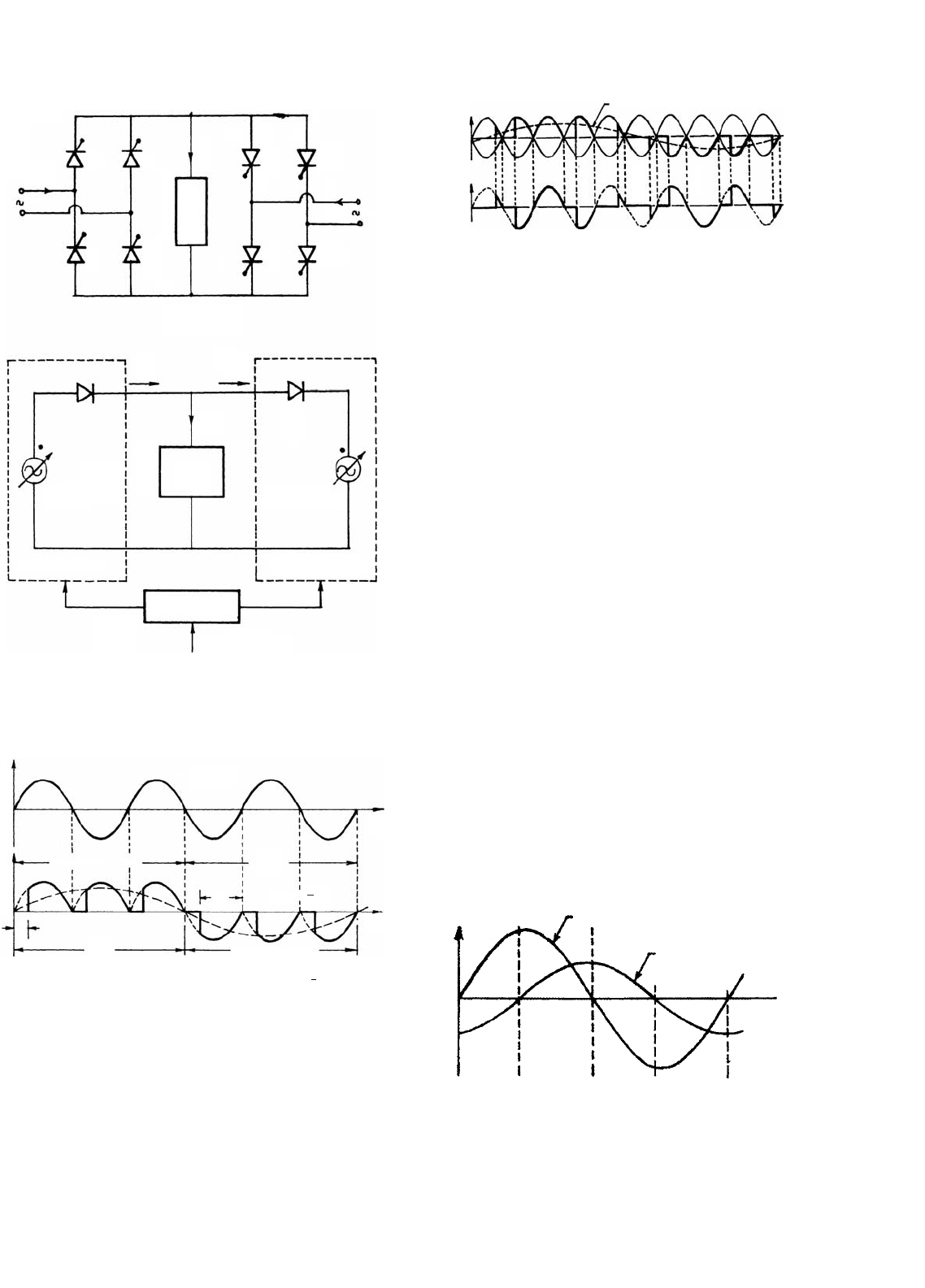
494 A. K. Chattopadhyay
P-Converter N-Converter
P
1
P
2
N
1
N
3
P
3
P
4
i
P
i
N
i
o
N
4
N
2
i
s
v
s
i
s
v
s
v
a.
c.
l
o
a
d
(a)
+
−
v
o
a. c.
l o a d
P-Converter N-Converter
Control circuit
(b)
v
P
= V
m
sinω
o
t
v
N
= V
m
sinω
o
t
+
−
i
o
e
r
= E
r
sinω
o
t
FIGURE 18.16 (a) Power circuit for a single-phase bridge cyclocon-
verter and (b) simplified equivalent circuit of a cycloconverter.
v
s
f
i
= 50Hz
To
/
2
To
/2
v
o
P-Converter ON
ON
N-Converter
0
α
p
α
N
0
fo = 16 Hz
2
3
ωt
ωt
FIGURE 18.17 Input and output waveforms of a 50–16
2
3
Hz cyclocon-
verter with RL load.
P-converter is equal and opposite to that of the N-converter.
The inspection of Fig. 18.17 shows that the waveform with α
remaining fixed in each half cycle generates a square wave hav-
ing a large low-order harmonic content. A near approximation
to sine wave can be synthesized by a phase modulation of the
Fundamental
(a)
(b)
i
s
v
e
i
e
FIGURE 18.18 Waveforms of a single-phase/single-phase cyclocon-
verter (50–10 Hz) with RL load: (a) load voltage and load current and
(b) input supply current.
firing angles as shown in Fig. 18.18 for a 50–10 Hz cyclocon-
verter. The harmonics in the load voltage waveform are less
compared to earlier waveform. The supply current, however,
contains a sub-harmonic at the output frequency for this case
as shown.
Operation with RL Load: The cycloconverter is capable of
supplying loads of any power factor. Figure 18.19 shows the
idealized output voltage and current waveforms for a lagging
power factor load where both the converters are operating as
rectifier and inverter at the intervals marked. The load cur-
rent lags the output voltage and the load current direction
determines which converter is conducting. Each converter
continues to conduct after its output voltage changes polarity
and during this period, the converter acts as an inverter and
the power is returned to the ac source. Inverter operation con-
tinues till the other converter starts to conduct. By controlling
the frequency of oscillation and the depth of modulation of the
firing angles of the converters (as shown later), it is possible to
control the frequency and the amplitude of the output voltage.
The load current with RL load may be continuous or dis-
continuous depending on the load phase angle, φ. At light load
inductance or for φ ≤ α ≤ π, there may be discontinuous load
current with short zero-voltage periods. The current wave may
contain even harmonics as well as sub-harmonic components.
Further, as in the case of dual converter, though the mean out-
put voltage of the two converters are equal and opposite, the
V
o
N-Conv.
inverting
P-Conv.
rectifying
N-Conv.
rectifying
P-Conv.
inverting
i
o
FIGURE 18.19 Idealized load voltage and current waveform for a
cycloconverter with RL load.
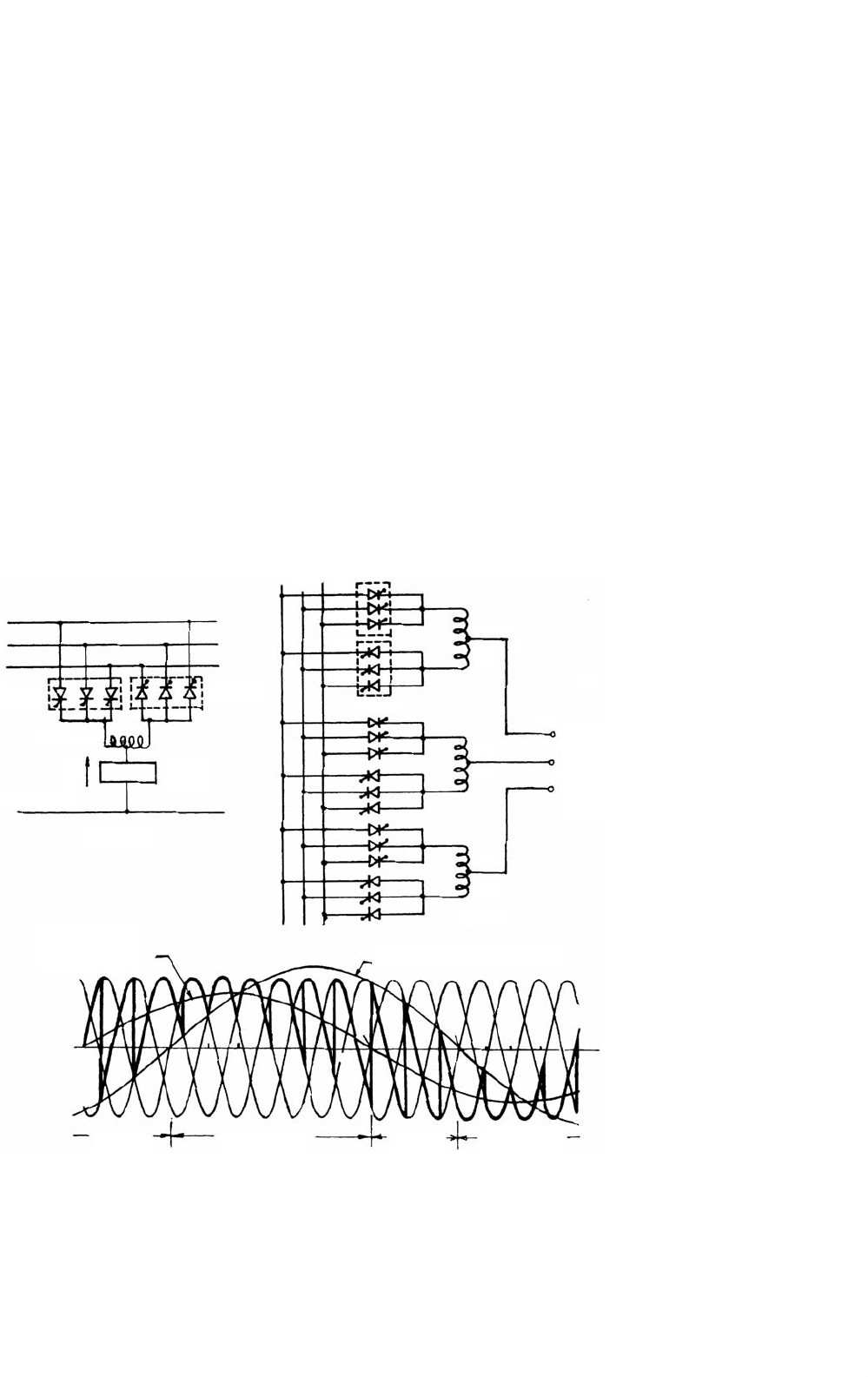
18 AC–AC Converters 495
instantaneous values may be unequal and a circulating current
can flow within the converters. This circulating current can be
limited by having a center-tapped reactor connected between
the converters or can be completely eliminated by logical con-
trol similar to the dual converter case when the gate pulses to
the converter remaining idle are suppressed, when the other
converter is active. In practice, a zero-current interval of short
duration is needed, in addition, between the operation of the
P- and N- converters to ensure that the supply lines of the two
converters are not short-circuited. With circulating current-
free operation, the control scheme becomes complicated if the
load current is discontinuous.
In the case of the circulating current scheme, the converters
are kept in virtually continuous conduction over the whole
range and the control circuit is simple. To obtain reasonably
good sinusoidal voltage waveform using the line-commutated
two quadrant converters and eliminate the possibility of the
short circuit of the supply voltages, the output frequency of
the cycloconverter is limited to a much lower value of the sup-
ply frequency. The output voltage waveform and the output
3PH, 50Hz SUPPLY P-GROUP
AB C pA
pA
T
h
pBpB
T
h
pCpC
T
h
nAnA
T
h
nBnB
T
h
nCnC
a
Variable voltage
Variable frequency
Output to 3-phase
load
b
c
Fundamental output current
Fundamental
output voltage
N-GROUP
L
/
2
L
/
2
L
/
2
L
/
2
L
/
2
L
/
2
N-converter
T
h
Load
Neutral
123
Inversion Rectification RectificationInversion
y
x
Reactor
P-converter
ABC
V
o
(a)
(b)
pA
T
h
pB
T
h
pC
T
h
nA
T
h
nB
T
h
nC
T
h
a b c d f g h i j keabc d f gh i j ke
D E FDEF
FIGURE 18.20 (a) Three-phase half-wave (three-pulse) cycloconverter supplying a single-phase load; (b) three-pulse cycloconverter supplying a
three-phase load; and (c) output voltage waveform for one phase of a three-pulse cycloconverter operating at 15 Hz from a 50 Hz supply and
0.6 power factor lagging load.
frequency range can be improved further by using converters
of higher pulse numbers.
18.4.2 Three-phase Cycloconverters
18.4.2.1 Three-phase Three-pulse Cycloconverter
Figure 18.20a shows the schematic diagram of a three-phase
half-wave (three-pulse) cycloconverter feeding a single-phase
load and Fig. 18.20b, the configuration of a three-phase half-
wave (three-pulse) cycloconverter feeding a three-phase load.
The basic process of a three-phase cycloconversion is illus-
trated in Fig. 18.20c at 15 Hz, 0.6 power factor lagging load
from a 50 Hz supply. As the firing angle α is cycled from
zero at “a” to 180
◦
at “j”, half a cycle of output frequency is
produced (the gating circuit is to be suitably designed to intro-
duce this oscillation of the firing angle). For this load, it can
be seen that although the mean output voltage reverses at X,
the mean output current (assumed sinusoidal) remains posi-
tive until Y. During XY, the SCRs A, B, and C in P-converter
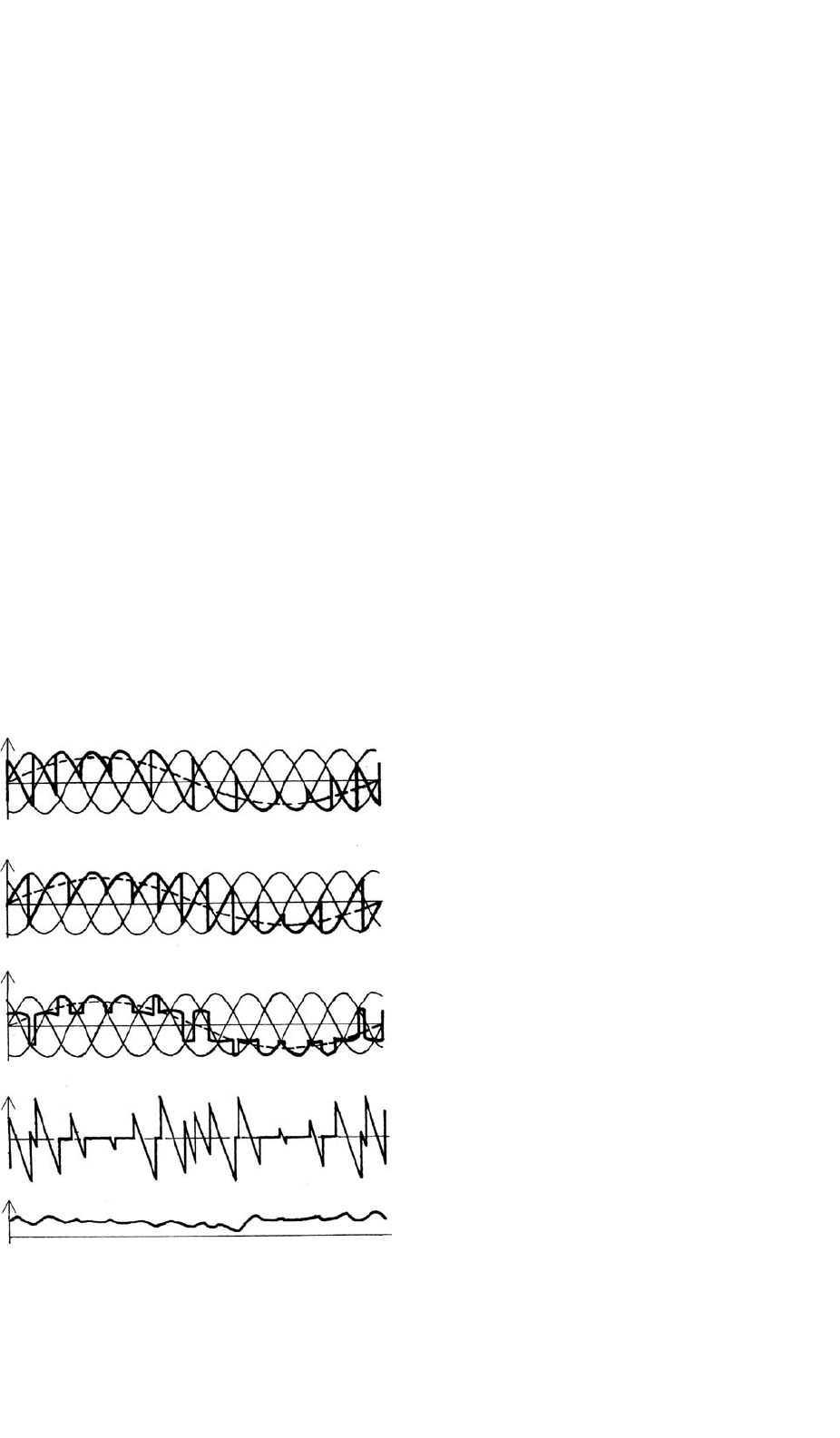
496 A. K. Chattopadhyay
are “inverting.” A similar period exists at the end of the nega-
tive half cycle of the output voltage when D, E, and F SCRs in
N-converter are “inverting.” Thus the operation of the con-
verter follows in the order of “rectification’ and “inversion”
in a cyclic manner, the relative durations being dependent
on load power factor. The output frequency is that of the
firing angle oscillation about a quiscent point of 90
◦
(condi-
tion when the mean output voltage, given by V
o
= V
do
cos α,
is zero). For obtaining the positive half cycle of the volt-
age, firing angle α is varied from 90
◦
to 0
◦
and then to 90
◦
and for the negative half cycle, from 90
◦
to 180
◦
and back
to 90
◦
. Variation of α within the limits of 180
◦
automatically
provides for “natural” line commutation of the SCRs. It is
shown that a complete cycle of low-frequency output voltage is
fabricated from the segments of the three-phase input voltage
by using the phase-controlled converters. The P-converter or
N-converter SCRs receive firing pulses which are timed such
that each converter delivers the same mean output voltage.
This is achieved, as in the case of single-phase cycloconverter
or the dual converter by maintaining the firing angle con-
straints of the two groups as α
P
= (180
◦
−α
N
). However, the
instantaneous voltages of two converters are not identical and
large circulating current may result unless limited by inter-
group reactor as shown (circulating-current cycloconverter)or
completely suppressed by removing the gate pulses from the
Rectifying
Rectifying
Inverting
Inverting
P-Converter
output voltage
N-Converter
output voltage
Output voltage
at load
Reactor voltage
Circulating current
FIGURE 18.21 Waveforms of a three-pulse cycloconverter with circulating current.
non-conducting converter by an inter-group blanking logic
(circulating-current-free cycloconverter).
Circulating-current Mode Operation: Figure 18.21 shows
typical waveforms of a three-pulse cycloconverter operating
with circulating current. Each converter conducts continu-
ously with rectifying and inverting modes as shown, and the
load is supplied with an average voltage of two converters
reducing some of the ripple in the process, the inter-group
reactor behaving as a potential divider. The reactor limits the
circulating current, the value of its inductance to the flow of
load current being one-fourth of its value to the flow of circu-
lating current as the inductance is proportional to the square of
the number of turns. The fundamental wave produced by both
the converters are the same. The reactor voltage is the instanta-
neous difference between the converter voltages and the time
integral of this voltage divided by the inductance (assuming
negligible circuit resistance) is the circulating current. For a
three-pulse cycloconverter, it can be observed that this current
reaches its peak when α
P
= 60
◦
and α
N
= 120
◦
.
Output voltage equation: A simple expression for the fun-
damental rms output voltage of the cycloconverter and the
required variation of the firing angle α can be derived with
the assumptions that (i) the firing angle α in successive half
cycles is varied slowly resulting in a low-frequency output
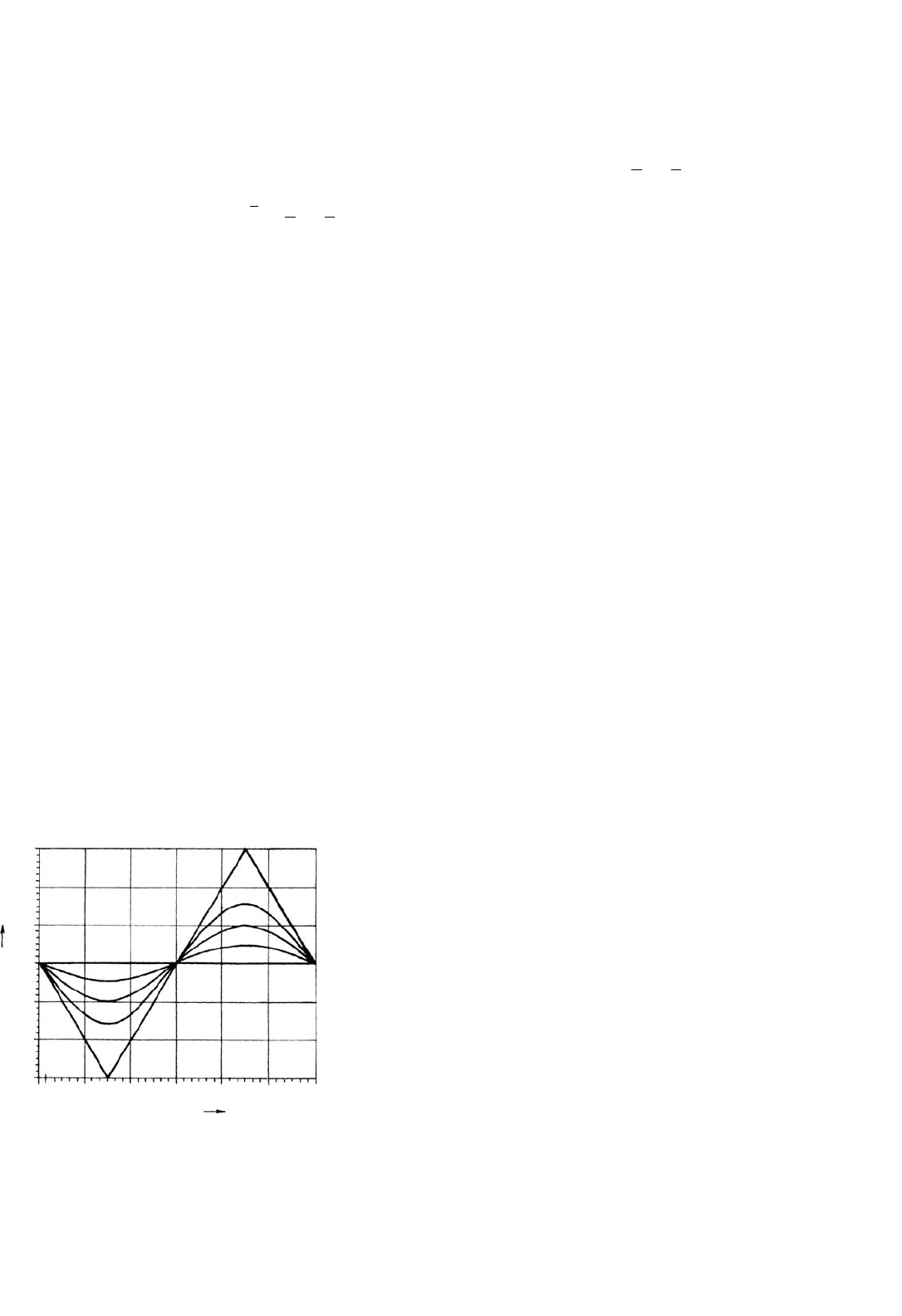
18 AC–AC Converters 497
(ii) the source impedance and the commutation overlap are
neglected (iii) the SCRs are ideal switches and (iv) the current
is continuous and ripple-free. The average dc output voltage
of a p-pulse dual converter with fixed α is
V
do
= V
domax
cos α, whereV
domax
=
√
2V
ph
p
π
sin
π
p
(18.25)
For the p-pulse dual converter operating as a cyclocon-
verter, the average phase voltage output at any point of the
low frequency should vary according to the equation
V
o,av
= V
o1, max
sin ω
o
t (18.26)
where V
o1,max
is the desired maximum value of the fundamen-
tal output of the cycloconverter.
Comparing Eq. (18.25) with Eq. (18.26), the required
variation of α to obtain a sinusoidal output is given by
α = cos
−1
[(V
o1, max
/V
domax
) sin ω
o
t]=cos
−1
[r sin ω
o
t]
(18.27)
where r is the ratio (V
o1,max
/V
domax
), the voltage magnitude
control ratio.
Equation (18.27) shows α as a non-linear function with
r (≤ 1) as shown in Fig. 18.22.
However, the firing angle α
P
of the P-converter cannot
be reduced to 0
◦
as this corresponds to α
N
= 180
◦
for the
N-converter which, in practice, cannot be achieved because of
allowance for commutation overlap and finite turn-off time of
the SCRs. Thus the firing angle α
P
can be reduced to a certain
finite value α
min
and the maximum output voltage is reduced
by a factor cos α
min
.
180
r=1
r=0.75
r=0.75
r=0.25
r=0.5
r=0
150
120
90
60
a (deg)
30
0
0 60 120
w
o
t (deg)
180 240 300 36
0
r=0.75
FIGURE 18.22 Variations of the firing angle (α) with r in a
cycloconverter.
The fundamental rms voltage per phase of either
converter is
V
or
= V
oN
= V
oP
= rV
ph
p
π
sin
π
p
(18.28)
Though the rms value of the low-frequency output voltage
of the P-converter and that of the N-converter are equal, the
actual waveforms differ and the output voltage at the midpoint
of the circulating current limiting reactor (Fig. 18.21) which
is the same as the load voltage, is obtained as the mean of the
instantaneous output voltages of the two converters.
Circulating Current-free Mode Operation: Figure 18.23
shows the typical waveforms for a three-pulse cycloconverter
operating in this mode with RL load assuming continuous
current operation. Depending on the load current direction,
only one converter operates at a time and the load voltage is
the same as the output voltage of the conducting converter.
As explained earlier in the case of single-phase cycloconverter,
there is a possibility of short-circuit of the supply voltages
at the cross-over points of the converter unless taken care of
in the control circuit. The waveforms drawn also neglect the
effect of overlap due to the ac supply inductance. A reduction
in the output voltage is possible by retarding the firing angle
gradually at the points a, b, c, d, e in Fig. 18.23. (This can be
easily implemented by reducing the magnitude of the reference
voltage in the control circuit.) The circulating current is com-
pletely suppressed by blocking all the SCRs in the converter
which is not delivering the load current. A current sensor
is incorporated in each output phase of the cycloconverter
which detects the direction of the output current and feeds an
appropriate signal to the control circuit to inhibit or blank the
gating pulses to the non-conducting converter in the same way
as in the case of a dual converter for dc drives. The circulating
current-free operation improves the efficiency and the dis-
placement factor of the cycloconverter and also increases the
maximum usable output frequency. The load voltage transfers
smoothly from one converter to the other.
18.4.2.2 Three-phase Six-pulse and Twelve-pulse
Cycloconverter
A six-pulse cycloconverter circuit configuration is shown in
Fig. 18.24. Typical load voltage waveforms for 6-pulse (with
36 SCRs) and 12-pulse (with 72 SCRs) cycloconverters are
shown in Fig. 18.25, the 12-pulse converter being obtained
by connecting two 6-pulse configurations in series and appro-
priate transformer connections for the required phase-shift.
It may be seen that the higher pulse numbers will generate
waveforms closer to the desired sinusoidal form and thus per-
mit higher frequency output. The phase loads may be isolated
from each other as shown or interconnected with suitable
secondary winding connections.
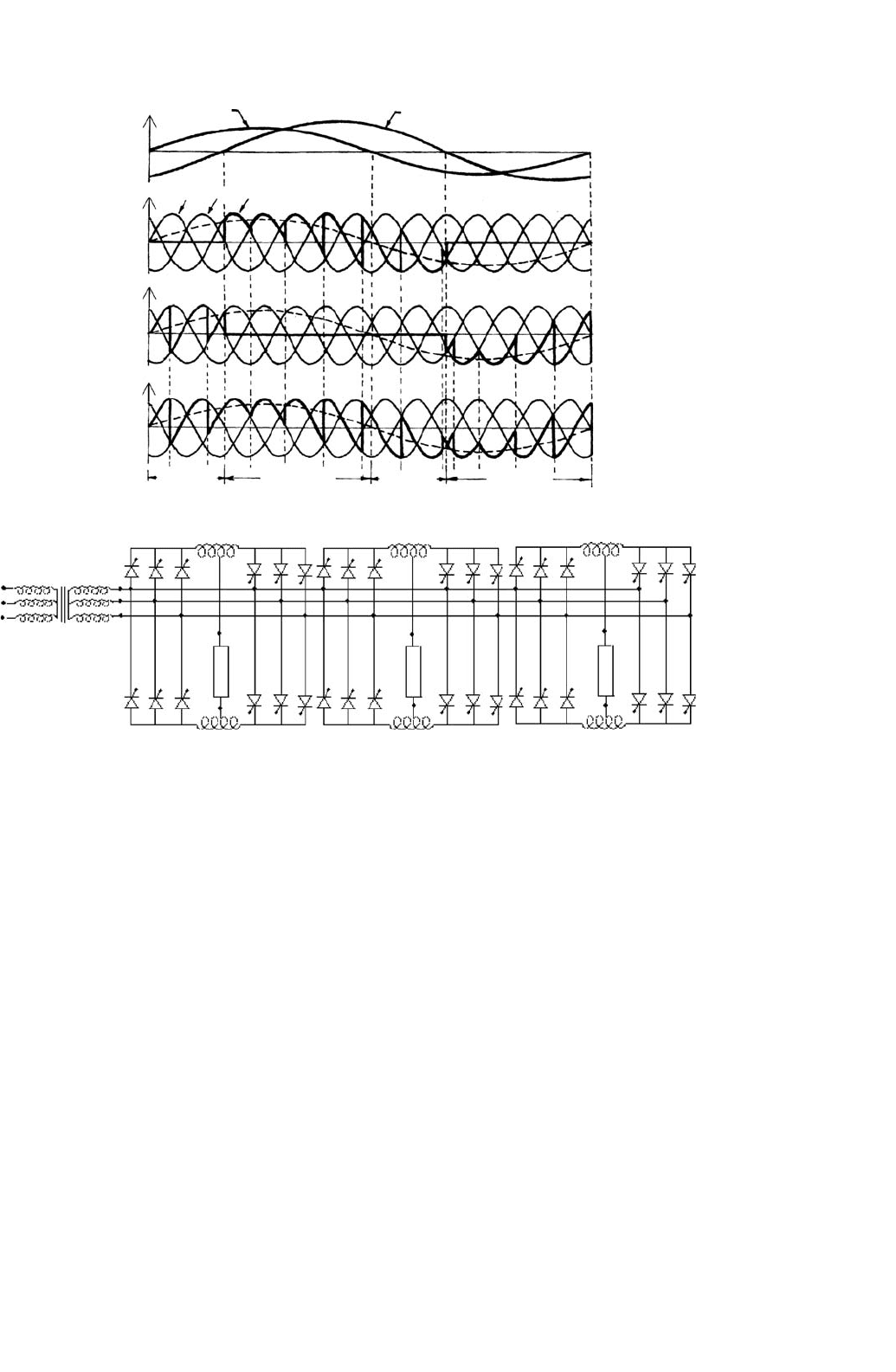
498 A. K. Chattopadhyay
Voltage
Desired
output
P-conv.
voltage
N-conv.
voltage
Load
voltage
Inverting Inverting
Rectifyinng Rectifying
Current
a
V
A
V
L
V
B
V
C
bc d e
FIGURE 18.23 Waveforms for a three-pulse circulating current-free cycloconverter with RL load.
A
3-phase input
B
C
LOAD
LOAD
LOAD
FIGURE 18.24 Three-phase six-pulse cycloconverter with isolated loads.
18.4.3 Cycloconverter Control Scheme
Various possible control schemes, analog as well as digital, for
deriving trigger signals for controlling the basic cycloconverter
have been developed over the years.
Out of the several possible signal combinations, it has been
shown [8] that a sinusoidal reference signal (e
r
= E
r
sin ω
o
t)
at desired output frequency f
o
and a cosine modulating signal
(e
m
= E
m
cos ω
i
t) at input frequency f
i
is the best combination
possible for comparison to derive the trigger signals for the
SCRs (Fig. 18.26 [9]) which produces the output waveform
with the lowest total harmonic distortion. The modulating
voltages can be obtained as the phase-shifted voltages (B-phase
for A-phase SCRs, C-phase voltage for B-phase SCRs, and
so on) as explained in Fig. 18.27, where at the intersection
point “a”,
E
m
sin(ω
i
t −120
◦
) =−E
r
sin(ω
o
t −φ)
or cos(ω
i
t −30
◦
) = (E
r
/E
m
) sin(ω
o
t −φ)
From Fig. 18.27, the firing delay for A-phase SCR,
α = (ω
i
t −30
◦
)
So, cos α = (E
r
/E
m
) sin(ω
o
t −φ)
The cycloconverter output voltage for continuous current
operation,
V
o
= V
do
cos α = V
do
(E
r
/E
m
) sin(ω
o
t −φ) (18.29)
in which the equation shows that the amplitude, frequency,
and phase of the output voltage can be controlled by con-
trolling corresponding parameters of the reference voltage,
thus making the transfer characteristic of the cycloconverter
linear. The derivation of the two complimentary voltage
waveforms for the P-group or N-group converter “banks” in
this way is illustrated in Fig. 18.28. The final cycloconverter
output waveshape is composed of alternate half cycle seg-
ments of the complementary P-converter and the N-converter
